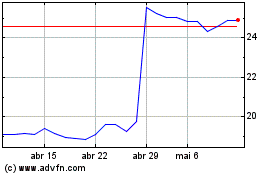Future Health Index 2024 global report: Healthcare leaders turn to AI to address critical gaps in patient care
18 Junho 2024 - 6:00AM

Future Health Index 2024 global report: Healthcare leaders turn to
AI to address critical gaps in patient care
June 18, 2024
- Healthcare leaders indicate automation is crucial in addressing
staff shortages, but staff remain skeptical
- Interest in Generative AI grows, with majority of health
leaders investing in, or planning to invest in AI technologies to
help reduce delays in patient care
Amsterdam, the Netherlands– Royal Philips
(NYSE: PHG, AEX: PHIA), a global leader in health technology, today
announced the results of its Future Health Index 2024 report:
Better care for more people. Launched at HLTH Europe, the ninth
annual FHI global report shows that healthcare leaders are turning
to virtual care and AI-enabled innovation to address pressure due
to workforce shortages, financial burdens, and growing demand.
“Increasingly, we’re seeing long wait times and staff shortages
making it difficult for people to get timely access to care when
and where needed. The Future Health Index 2024 global findings show
health leaders believe these barriers to access to quality care are
getting larger,” said Shez Partovi, Chief Innovation & Strategy
Officer at Philips. “This year’s report shows how innovations
including AI are helping to free up time for staff and reduce wait
times for patients. However, as health systems roll out AI tools to
save time and reduce barriers to care, it’s critical to bring staff
along on the journey to ensure an inclusive AI rollout with patient
and clinician experience is at the forefront.”
Staff shortages are taking a heavy toll on healthcare
professionals and patients Almost two-thirds (66%) of
healthcare leaders report increased incidence of burnout, stress,
and mental health issues in their workforce, deterioration of
work-life balance, and/or reduced morale and engagement. Delays in
care due to staff shortages are an issue for more than three in
four healthcare leaders (77%) – causing concerns about increased
waiting lists for appointments (60%), longer waiting times for
treatments or procedures (57%), or delayed or limited access to
screening, diagnosis, and preventive care (54%).
"The results of the FHI Report and the 3 critical gaps
identified align perfectly with the challenges I face in my
clinical practice each day. The staffing gap is the most concerning
aspect as it has a direct negative impact on patient care. As
health leaders, we need to focus on increasing the adoption of
digital technologies to improve efficiency and reduce the workload,
but not without engaging with healthcare staff to ensure adoption
of these technologies is embraced,” said Prof. Dr. Chiara
Bucciarelli-Ducci, cardiologist and CEO of the Society for
Cardiovascular Magnetic Resonance (SCMR), London, UK.
Automation can help ease the burden on
staffMost healthcare leaders (92%) agree that using
technology to automate repetitive tasks or processes is critical
for addressing staff shortages in healthcare. However, nearly
two-thirds (65%) say healthcare professionals are skeptical about
its use. Concerns were raised around automation and quality
assurance and the potential for overreliance on automation leading
to staff losing essential skills and knowledge. Today, automation
mainly reduces the administrative burden; however, two in five
(41%) healthcare leaders plan to implement it for workflow
prioritization.
Virtual care may also help bridge the staffing gap, with 89% of
leaders already seeing a positive impact of virtual care in easing
shortages. Leaders also see benefits for staff satisfaction with
more than half (54%) saying virtual care enables more flexible work
schedules and creates new career options for healthcare
professionals.
Patients also benefit from remote monitoring which can offer
more positive experiences while reducing the strain on
overstretched hospital staff. Leaders see a bigger role for remote
patient monitoring in the future and are planning an expansion into
areas such as telestroke care (40%), maternal and fetal health
(36%), and postoperative monitoring (35%) within the next three
years.
Health leaders keenly interested in Generative
AI Last year’s report showed leaders were planning
investments in AI; however, the FHI 2024 results show AI for
clinical decision support is already being leveraged for
in-hospital patient monitoring (43%), with more investments planned
in the next three years. Additionally, the majority of leaders
(85%) are currently investing in, or planning to invest in,
generative AI technologies.
Financial challenges must be addressed through
sustainable strategiesThe vast majority (81%) of leaders
note that financial challenges are having a direct impact on
patients. Almost 3 in 5 (59%) are unable to invest in new or more
advanced medical equipment or technologies. At the same time, 89%
are planning growth strategies to serve more patients or expand
services. Additionally, 86% of healthcare leaders also believe that
reducing CO2 emissions and the environmental impact of healthcare
should be a top priority for healthcare organizations, meaning that
any strategies to address financial challenges must be
sustainable.
The FHI 2024 report is based on proprietary research among 3,000
healthcare leaders conducted in 14 countries. To access this year’s
report, visit Future Health Index 2024.
For further information, please contact:Kathy
O’ReillyPhilips Global External RelationsTel.: +1
978-221-8919E-mail: Kathy.OReilly@philips.com
About Royal Philips
Royal Philips (NYSE: PHG, AEX: PHIA) is a leading health
technology company focused on improving people's health and
well-being through meaningful innovation. Philips’ patient- and
people-centric innovation leverages advanced technology and deep
clinical and consumer insights to deliver personal health solutions
for consumers and professional health solutions for healthcare
providers and their patients in the hospital and the home.
Headquartered in the Netherlands, the company is a leader in
diagnostic imaging, ultrasound, image-guided therapy, monitoring
and enterprise informatics, as well as in personal health. Philips
generated 2023 sales of EUR 18.2 billion and employs approximately
69,100 employees with sales and services in more than 100
countries. News about Philips can be found
at www.philips.com/newscenter.
- A clinician in consultation with a patient
- A clinician in discussion with a young patient
- Future Health Index 2024 report infographic
- The Future Health Index 2024 report: Better care for more
people
- A pregnant woman with a young child
Koninklijke Philips NV (EU:PHIA)
Gráfico Histórico do Ativo
De Out 2024 até Nov 2024

Koninklijke Philips NV (EU:PHIA)
Gráfico Histórico do Ativo
De Nov 2023 até Nov 2024


